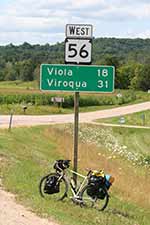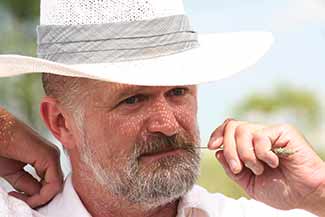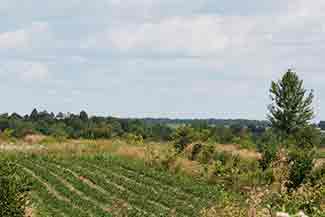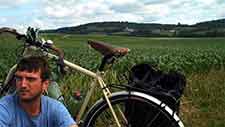VIOLA, WISCONSIN. Short of breath and drenched in sweat, I arrived at New Forest Farm on a late August afternoon. All my life I had envisioned the state of Wisconsin and the Midwest to be completely flat. I was wrong. When the glaciers roared through North America a few thousand years ago and flattened the heartland, they had overlooked a spot or two in southwest Wisconsin. This region is known as the “driftless area,” and the beautiful and diverse landscape awed me. The bounty of green rolling hills partnered with well defined river valleys carved out of the landscape.
I stood waiting in front of the New Forest Farm cider making facility and tasting room. With a big smile on his face, Mark Shepard rolled towards me in an older model Subaru. Before I could even introduce myself and shake Mark’s hand, he reminded me that I was late. It was true. I was late. However, Mark wasn’t the one who had to climb the hills of Vernon County on a bicycle. I took Mark’s reminder with a grain of salt.
Mark Shepard owns and runs New Forest Farm and its 140 acres of trees, shrubs, vines, canes, perennial plants, fungi, hazelnuts, chestnuts, walnuts, various fruits and other woody crops scattered throughout the landscape. Mark and his family had transformed what was once a typical row-crop farm into a commercial-scale permaculture mecca.
What exactly is permaculture? This lingering question led me to Viola, Wisconsin to stay with Mark Shepard. One of the most ambitious and passionate permaculture designers in the country. According to Wikipedia, permaculture is “the development of agricultural ecosystems intended to be sustainable and self-sufficient.” According to Mark Shepard, it is merely common sense and the future of food and fuel production. At first glance New Forest looks more like a wild jungle of brush, tall grasses, and weeds rather than any type of productive farm. I would soon understand how harmonious and productive Mark’s wild and abundant landscape could be. Understanding the design behind symbiotic relationships were the key.
Mark and I climbed into his car and drove around the property for preliminary tour. Weeds and grasses made loud scratching noises as they scraped the bottom of the floorboards. As the old Subie bounced up and down, Mark got me up to speed on his impressive background and diverse repertoire of skills that included extensive training in both mechanical engineering and ecology, coupled with a certification in permaculture design from Bill Mollison, the founder of the international Permaculture movement. Mark has also developed and patented various pieces of equipment used in the process of cultivation and harvesting vegetables, fruit, and nut trees.
Just a stone’s throw away from Mark’s off-grid house, I was introduced to a young couple who were living on the farm. The young girl had a shaved head, wore zebra striped socks and pink tennis shoes. The young man had more hair in his beard than he did on his head. They were building a small structure that would be their summer housing. “I hope the summer winds are calm in Wisconsin,” I thought to myself as I evaluated the young couple’s carpentry skills. To make matters more interesting, the young girl had recently learned she was pregnant. A small glimmer of fear was evident in their eyes; leaving me intrigued and slightly concerned for them both. Two young people building a makeshift structure with no “job” or health insurance during a pregnancy. It felt dangerous, real, and wild.
Mark offered the young couple a snippet of building instructions and we quickly drove off. “I guess those are your interns?” I asked. “We don’t call them interns here. We do things a little bit differently. We didn’t want to run a farm that was based on slave labor in the way of interns. We also don’t want to pay employees, who will ultimately, hurry up to get the job done because they are underpaid. We allow people to come here and work on their own enterprises. As long as their goals fit in within our overall design they are welcome to show up and make a go of it.”
As a young man with no destination or concrete plan in mind, I found my curiousity piqued by Mark’s vision. In the passenger seat of Mark’s car, my imagination travelled ahead to the end of summer. What if I had stayed on Mark’s farm, learning more about permaculture and finding out if I really had the moxie to pursue farming?
I snapped out of my daydream to Mark bellowing in my left ear, “Learning how to farm isn’t about pulling weeds in some farmer’s field for free and having a wonderful summer experience. It’s about knowing how to work the system and how to manage your cash flow.” I nodded and agreed with Mark.“You need to learn what to do when you get a ton of money from asparagus in the spring and don’t make a dime until winter squash is harvested in the fall. We encourage the people who come here to learn both how to grow food sustainably and earn an income on their own.”
Garin Smith on Grassland Organic Farm, Mimi Arnstein back at Wellspring CSA and other farmers I had met along the way had also proven to me that being a farmer went hand in hand with entrepreneurship. Whether you farm with organic or conventional practices and no matter how large or small of a scale in which you operate – any new farmer must be prepared to take on the role of a business owner and manage cash flow. Those who do not… will fail.
Mark’s philosophy was rejuvenating. It gave new and potential farmers a real chance to experience and understand farming. Without the romantic notions of a summer internship on the farm.
Brilliant shades of blue and purple filled the Midwestern sky as the sun gently sank beneath the Wisconsin hilltops. I thanked Mark for his hospitality and wandered off to a grassy field where I pitched my tent for a good night’s sleep.
The next morning I found my typical routine; involving coffee and a lollygag stroll with camera in hand. The discovery of random patches of asparagus, heritage pigs and Mark’s children working in the garden kept me occupied until a large bus pulled up and dropped off a group of tourists who had come for a tour of New Forest Farm. Farm tours are one of Mark’s value-added income sources and one of his many special talents. The crowd was a made up mostly of middle-aged men and women wearing khaki’s and sunscreen. Before the tour began I couldn’t help but eavesdrop just a little bit. Michael Pollan, factory farms, Organic Valley, and genetically modified crops were all topics that were tossed around. Back at Tantre Farm in Michigan, farmer Richard Andres described groups of people such as this as the “tip of the real food antenna” educated and looking to break free from the industrial food model. Suddenly, with his distinct and assertive voice, Mark demanded attention from the crowd. He was able to herd the cats in just a few seconds.
Mark began his tour describing shelter belts, chestnut blight, and saving seed. Within just a few minutes the inevitable happened. One of the tourists asked if the biotech behemoth Monsanto was interested in permaculture. Mark didn’t feel the need to badmouth Monsanto (at least not during this tour) but he did make an interesting point about the seed industry itself. Why is it that crop farmers have abdicated their responsibility for breeding their own stock? “Livestock farmers still do their own breeding. They take care of their herd and make sure that only the prize bulls are implemented. The cows that don’t perform are pulled out and the cows that aren’t prized get castrated and turned into beef. Why should plants and seeds be any different?” Mark then pulled out what appeared to be rehearsed joke. “One thing that is really interesting about sexual reproduction is that most species really enjoy it. So it’s not all that difficult to become successful at reproduction.”
Mark changed the subject and kept the tour moving, as he pointed over to a field in the distance and said “If you look over there you will see a field with barley and yellow sweet clover. We give that field an entire year off. Our two main annual crops are squash and peppers, which we have in rotation. We are growing that field of barley not for food or feed but for the sole purpose of soil building.” Mark began to reference the conventional method of composting where many farmers would harvest the barley, chop it up, put it into big piles and call it compost. Stir the compost a few times, put it in a front end loader and spread it on the field. “That makes no sense to me. What we do is mull it in place and let it rot on the field and eliminate all of those steps. For one year all we do is produce organic matter, creating a nice thick layer of compost ready for our squash”. Mark Yelped.
Mark’s ingenuity had the crowd going. His jokes drew full-size bouts of laughter and as the tour continued, the tourists would often look at each other with amazement as “This is amazing!” and “Wow! This is absolutely brilliant” “Do you have a model that you are using or do you just make this stuff up like a genius as you go along?” asked a woman from the crowd with highlighted hair and painted nails. Mark answered without hesitation, “In this country there is no traditional model for all of this stuff. In fact, when it comes to producing some of the many crops that we have growing here I tend to annoy the top researchers of each crop. The asparagus and the chestnut people know that I am doing this all wrong.” Mark uses the word “wrong” followed by a long pause – waiting to hear if anyone has picked up on his condescending remark. A few chuckles are drawn and he continued on. “They think I am just some crackpot in Southwest Wisconsin. In other places of the world this is and has been the traditional way of doing semi-nomadic agriculture. What we have now in modern agriculture is the ability to plant in a linear design and the luxury of mechanical harvesting. But that will not sustain us and the model that we use should always be modeled around nature.” Mark’s rhetoric and the natural landscape of New Forest Farm had rattled my emotions and had sent my brain to a faraway place where the smell of the natural world was untouched and in its original and natural state.
I looked around at the mosaic of species, plants and food growing in abundance,a cool breeze passed through. I saw that the natural world is made up of an infinite labyrinth of sizes, shapes, and vast ecosystems. And straight lines are not native to planet Earth. Everything at New Forest started to make perfect sense. And while most farmers were busy planting crops in a linear fashion and compartmentalizing production, Mark Shepard was bypassing all of the nonsense that comes with modern food production.
Mark whisked the group over to the next ecological attraction and broke into one of his interesting storytelling sessions. “Does anybody know what this is?” Nobody (including me) able to identify the plant Mark pointed out. “This is a Siberian Peashrub” (Which I later learned is a small perennial shrub generally used for medicinal purposes.) “I was up in Saskatchewan at a series of conferences where they brought me in as the crazy agro forester from the states.” I could see why they would feel that way. When Mark got on a roll and started in on one of his discoveries, he appeared to be a bit of a madcap. “The Canadians were having a problem with Siberian pea shrub that had been invading all of their canola fields.
Canola is big business in Canada as most of our bio diesel comes from their crops. They were all trying to figure out how to eradicate this Siberian Pea shrub and I was trying to figure out how to harvest it. I said to them, ‘Here is a plant that is kicking your butt and invading your canola fields. Why not plant it on purpose?!’ It grows its own nitrogen, has a wood property, which you can burn as biomass and has more oil, nutrition, protein, vitamins and minerals than canola. What’s the problem? They were just absolutely stunned that I would actually say such things.” The message that Mark was trying to deliver at both the Canadian conference and to the farm tourists, was that permaculture is not about a bunch of happy little hippies in the backyard growing a few potatoes. Mark was talking about production agriculture for our essential resources. “Once all of the mega corporations realize that perennials are the most economical way to grow carbohydrates, protein and oil they will be on it quick.” Making a sly joke, Mark added “Especially when oil prices go through the roof.” That comment drew quite a few mm’s from the crowd.
Mark seemed to have everyone’s tail over a teakettle just waiting to see and hear what was next in queue. Leaving nobody disappointed, Mark began explaining the beauty of his apple trees. Anyone who has eaten an apple from both the supermarket and the backyard knows and understands the difference in appearance. The grocery store fruit will be perfect in shape, waxy, and without blemish… or flavor for that matter. The fruit from the backyard often come with scars, scabs, and mushy bruises, and are filled with a zesty of flavor. What most consumers do not consider is the cost of production and inputs for a fruit producer, especially the organic fruit producer. Non-synthetic sprays, time, and labor do not come cheap to the fruit farmer. Trying to convince consumers to buy apples with a blemish or two was child’s play to Mark. The real challenge was to try and convince farmers themselves to change their practices by minimizing time and money spent on production and maximizing their profits via the work done by Mother Nature. “Why is it that organic apple growers are spending forty bucks on inputs to produce a twenty dollar box of fruit?” Mark asked. With the crowd captivated and silent he shouted, “It doesn’t make any sense. That doesn’t work. The answer is because they are striving for the ‘Grade A’ fruit. I ask, Why?!’ Why would a farmer want to lose $10,000 an acre to produce all of that fruit? What I do is spend nothing on sprays and the only costs I incur is the cost of harvest; which is minuscule. I can still get Grade A fruit. Sure, I won’t get as much Grade A fruit as the person who spends thousands on sprays; but I can take the apples that drop to the ground and feed them to my pigs.
The apples that are still on the tree but look too ugly for the super market can get pressed into cider, which then gets fermented into alcohol.” Cider making dates back to 1300 BC. On New Forest Farm it was Mark’s new and cherished enterprise. Using blemished apples to produce hard cider and pig food was logical, but didn’t strike me as all that brilliant. What did impress me was Mark’s vision to turn apples into bio-fuel. “We know that Brazil gets a ton of alcohol and is fueling their cars from their sugar cane industry. Why can’t we do the same with apples?” Mark exclaimed. “Think about it! Unlike corn where we need to take starch and convert it into sugar, an apple is jam packed with sugar. Yes, you will get less ethanol per acre from apples than you would from corn, but the energy that it takes to accomplish the end result is far more efficient, profitable and sustainable.” Mark then yells “Apples are just one example.” Mark continued to rant.
Amish farmer Daniel Kline impressed me with his rotationally grazed livestock. Meagan Kresge inspired me by way of turning an abandoned parking lot into a small farm. But Mark Shepard’s vision was on a completely different level. A level that seemed unreachable to most individuals and inconvenient to many farmers. Mark Shepard was not preaching the gospel of sustainable agriculture. He was trailblazing a path for a new paradigm of food and fuel production. What he said made both dollars and sense.
With a few odd looks from the crowd, Mark began to extrapolate the meaning of his passions and hammered home his point by making a valuable observation. “There is a market for anything that you could possibly grow in a diverse ecosystem. Don’t believe me? Walk into Wal-Mart, go to the pill section and read the labels on back of the bottles. You will find things like burdock root and thistle flower. If Wal-Mart is carrying these products I can assure you that it is not a niche product and that it is in fact a huge industrial product.”
My neighbor across the way is selling corn for $2 a bushel and I am selling thistle flower for $13.50 a bushel. I don’t have to spend any money on planting or fertilizing thistle! The point is not to get stuck spending time, money and resources trying to save something that wants to die. The only two things that are always asked in agriculture are 1. How do I kill this thing that wants to live? And 2. How do I keep this thing alive that wants to die? We waste so much time trying to figure out the answer to those two simple questions.”
Smiles showing and energy flowing, the crowd of tourist got back on the bus and returned to their lives somewhere else. Most likely, places that were nothing like New Forest Farm.
Mark, his wife, their two children and the two eccentric “non-interns” and I made our way inside for dinner where the pros and cons of taking a personal journey came rushing up to greet me. Just before my mind had dipped into a betwixt spiral and before we dug our forks into a plate full of food, everyone, but me, joined hands and began singing the popular Shaker song ‘Tis the Gift to be Simple’ written by Elder Joseph Brackett. It goes like this:
‘Tis the gift to be simple, ’tis the gift to be free,
‘Tis the gift to come down where we ought to be,
And when we find ourselves in the place just right,
‘Twill be in the valley of love and delight.
When true simplicity is gain’d,
To bow and to bend we shan’t be asham’d,
To turn, turn will be our delight,
Till by turning, turning we come round right.
I had never heard that song. For all I had known these people sitting around me were the only ones who could possibly have known the words and for a moment I was convinced that they had made the song and it’s lyrics up entirely on their own. For a nanosecond I was starting to wonder if I was visiting a sustainable farm or if I had made my way onto some bizarre permaculture cult.
I was feeling torn and uncomfortable. On one hand, the information that I had been absorbing during my time at New Forest was invaluable. On the other, knowing that I knew so little about permaculture in comparison to Mark was testing the waters of my emotional comfort zone. Here I was – a touted “food hero on a bike” discovering and sharing information surrounding our nation’s farmers and food system. I had major press articles written about my journey and had thousands of people following me online. I had even started writing this book. Everywhere I had gone people were asking me to share my experiences and tell enlightening stories about what I had come to learn and know. At New Forest Farm I was nothing special. At least that is how I felt. In fact, I was feeling as though I had little value to add to the conversation. Hell, I was raised in Lancaster County, Pennsylvania; a state founded by famous Quaker, William Penn and had never even heard the Quaker hymn we all shared before dinner.
Admitting to myself that I was feeling insecure and out of place was not an easy task. But I did it. And I was humbled. New Forest Farm was a brilliant place. I struggled to find more than one good reason to leave. However, I had just arrived to a brand new place psychologically that left me with a lingering sense of confusion and doubt. I needed to be alone. I returned to my campsite and the next morning I got back on my bicycle and set out on another back country road- a familiar and safe place that had become my sanctuary for personal exploration.
Read the Unconventional Harvest series:
- On the Road to Find the Future of Food and Farming
- Grassland Organic Farm
- Wellspring Farm
- My Visit to an Amish Farm in New York
- Farm Sanctuary
- An Urban Oasis for Food
- Tantré Farm
- Conventional Dairy Farmer Art Thelen
- New Forest Farm
- A Large No-Till Organic Farm
- Melstone, Montana—Population 136
- In the Farmers Own Words
Nathan Winters rode a bicycle across America to discover first-hand why our food system had grown to be unsustainable, and to find alternative solutions. He traveled into the homes and communities of organic, conventional, urban and Amish farmers and community organizers. This ongoing series—to be posted every other Wednesday— represents select material from The Unconventional Harvest, a work in progress, by Nathan A. Winters.




